CO2 Hydrogenation to Synthetic Natural Gas over Ni, Fe and Co–Based CeO2–Cr2O3
Abstract
:1. Introduction
 CH4 + 2H2O, ∆Hr298 = −164.8 kJ·mol−1 [7]. Although the reaction is highly exothermic and thermodynamically favored at high pressures/low temperatures (<400 °C) [4,8], there are significant kinetic limitations due to the high stability of CO2. Furthermore, heat accumulation from the reaction generally causes severe hotspots in the reactor, due to the heat transfer limitation within the process, leading to the catalyst deactivation and shortened catalyst lifespan [9]. Moreover, low operating temperature is favorable for CO disproportionation reaction (2CO
CH4 + 2H2O, ∆Hr298 = −164.8 kJ·mol−1 [7]. Although the reaction is highly exothermic and thermodynamically favored at high pressures/low temperatures (<400 °C) [4,8], there are significant kinetic limitations due to the high stability of CO2. Furthermore, heat accumulation from the reaction generally causes severe hotspots in the reactor, due to the heat transfer limitation within the process, leading to the catalyst deactivation and shortened catalyst lifespan [9]. Moreover, low operating temperature is favorable for CO disproportionation reaction (2CO  CO2 + C, ∆Hr298 = −172.4 kJ·mol−1), resulting in unwanted coke deposition. In order to obtain the highest possible methane yield, it is necessary to invent a catalyst which enhances the reaction’s activity, withstands sintering and counters the coking phenomenon. Various active metals (such as Ni, Fe, Co, Ru, Rh, and Pd) have been used as an active site while metal oxides (such as CeO2, La2O3, MgO, γ-Al2O3, SiO2, TiO2, and ZrO2) have been useful as a support in a catalyst system for the CO2 methanation reaction [3,10,11,12,13]. Amongst these materials, CeO2 is so far found to be the most interesting support due to its high oxygen storage capacity (OSC) and its ability to disperse the active site [14]. In addition, CeO2 could promote the interaction between support and metal active component, such that the growth and dispersion of the metal active particles can be well distributed and controlled throughout the surface of the support, leading to the higher CO2 conversion [15]. The number oxygen vacancy can be tailor-made by substituting smaller transition metal ions (e.g., chromium ions) into CeO2. The higher number of lattice oxygen can combust coke deposits and reduce the chance of sintering [13,16,17,18]. According to previous research, Ni-, Fe-, Co doped on CeO2 have shown relatively high activities for CO2 methanation and possessed high stability when tested for 15 to 50 h reaction times [19,20,21,22,23].
CO2 + C, ∆Hr298 = −172.4 kJ·mol−1), resulting in unwanted coke deposition. In order to obtain the highest possible methane yield, it is necessary to invent a catalyst which enhances the reaction’s activity, withstands sintering and counters the coking phenomenon. Various active metals (such as Ni, Fe, Co, Ru, Rh, and Pd) have been used as an active site while metal oxides (such as CeO2, La2O3, MgO, γ-Al2O3, SiO2, TiO2, and ZrO2) have been useful as a support in a catalyst system for the CO2 methanation reaction [3,10,11,12,13]. Amongst these materials, CeO2 is so far found to be the most interesting support due to its high oxygen storage capacity (OSC) and its ability to disperse the active site [14]. In addition, CeO2 could promote the interaction between support and metal active component, such that the growth and dispersion of the metal active particles can be well distributed and controlled throughout the surface of the support, leading to the higher CO2 conversion [15]. The number oxygen vacancy can be tailor-made by substituting smaller transition metal ions (e.g., chromium ions) into CeO2. The higher number of lattice oxygen can combust coke deposits and reduce the chance of sintering [13,16,17,18]. According to previous research, Ni-, Fe-, Co doped on CeO2 have shown relatively high activities for CO2 methanation and possessed high stability when tested for 15 to 50 h reaction times [19,20,21,22,23].2. Methodology
2.1. Catalyst Powder-Formed Preparation
2.2. Characterizations
2.3. CO2 Methanation Activity in a Packed-Bed Reactor
3. Results and Discussion
3.1. Characterizations
3.1.1. XRD
3.1.2. H2-TPR
3.2. Catalytic Performance Test
3.2.1. Choice of the Monometallic
3.2.2. Effect of Metal Content on Catalytic Performance
3.2.3. Effect of Reduction Temperature on Catalytic Performance
3.3. Catalytic Stability
4. Conclusions
Author Contributions
Funding
Conflicts of Interest
References
- Blunden, J.; Arndt, D.S. State of the Climate in 2018. Bull. Am. Meteorol. Soc. 2019, 100, S1–S429. [Google Scholar] [CrossRef] [Green Version]
- Cheah, W.Y.; Ling, T.C.; Juan, J.C.; Lee, D.-J.; Chang, J.-S.; Show, P.L. Biorefineries of carbon dioxide: From carbon capture and storage (CCS) to bioenergies production. Bioresour. Technol. 2016, 215, 346–356. [Google Scholar] [CrossRef]
- Nie, W.; Zou, X.; Chen, C.; Wang, X.; Ding, W.; Lu, X. Methanation of Carbon Dioxide over Ni–Ce–Zr Oxides Prepared by One-Pot Hydrolysis of Metal Nitrates with Ammonium Carbonate. Catalysts 2017, 7, 104. [Google Scholar] [CrossRef]
- Gao, J.; Liu, Q.; Gu, F.; Liu, B.; Zhong, Z.; Su, F. Recent advances in methanation catalysts for the production of synthetic natural gas. RSC Adv. 2015, 5, 22759–22776. [Google Scholar] [CrossRef]
- Chisholm, G.; Cronin, L. Hydrogen from Water Electrolysis; Elsevier: Amsterdam, The Netherlands, 2016; pp. 315–343. [Google Scholar]
- Huynh, H.L.; Yu, Z. CO2 Methanation on Hydrotalcite-Derived Catalysts and Structured Reactors: A Review. Energy Technol. 2020, 8. [Google Scholar] [CrossRef] [Green Version]
- Kierzkowska-Pawlak, H.; Tyczkowski, J.; Balcerzak, J.; Tracz, P. Advances in plasma produced CoOx-based nanocatalysts for CO2 methanation. Catal. Today 2019, 337, 162–170. [Google Scholar] [CrossRef]
- Zhao, B.; Chen, Z.; Chen, Y.; Ma, X. Syngas methanation over Ni/SiO2 catalyst prepared by ammonia-assisted impregnation. Int. J. Hydrog. Energy 2017, 42, 27073–27083. [Google Scholar] [CrossRef]
- Rostrup-Nielsen, J.; Pedersen, K.; Sehested, J. High temperature methanation: Sintering and structure sensitivity. Appl. Catal. A Gen. 2007, 330, 134–138. [Google Scholar] [CrossRef]
- Moghaddam, S.V.; Rezaei, M.; Meshkani, F.; Daroughegi, R. Carbon dioxide methanation over Ni-M/Al2O3 (M: Fe, CO, Zr, La and Cu) catalysts synthesized using the one-pot sol-gel synthesis method. Int. J. Hydrog. Energy 2018, 43, 16522–16533. [Google Scholar] [CrossRef]
- Shen, W.-J.; Okumura, M.; Matsumura, Y.; Haruta, M. The influence of the support on the activity and selectivity of Pd in CO hydrogenation. Appl. Catal. A Gen. 2001, 213, 225–232. [Google Scholar] [CrossRef]
- Takoudis, C.G. The catalytic synthesis of hydrocarbons from H2/CO mixtures over the group VIII metals: Comments on methanation kinetics. J. Catal. 1982, 78, 265. [Google Scholar] [CrossRef]
- Tsiotsias, A.I.; Charisiou, N.D.; Yentekakis, I.V.; Goula, M.A. The Role of Alkali and Alkaline Earth Metals in the CO2 Methanation Reaction and the Combined Capture and Methanation of CO2. Catalysts 2020, 10, 812. [Google Scholar] [CrossRef]
- Wang, F.; He, S.; Chen, H.; Wang, B.; Zheng, L.; Wei, M.; Evans, D.G.; Duan, X. Active Site Dependent Reaction Mechanism over Ru/CeO2 Catalyst toward CO2 Methanation. J. Am. Chem. Soc. 2016, 138, 6298–6305. [Google Scholar] [CrossRef] [PubMed]
- Le, T.A.; Kim, M.S.; Lee, S.H.; Kim, T.W.; Park, E.D. CO and CO2 methanation over supported Ni catalysts. Catal. Today 2017, 293-294, 89–96. [Google Scholar] [CrossRef]
- Liu, Q.; Zhong, Z.; Gu, F.; Wang, X.; Lu, X.; Li, H.; Xu, G.; Su, F. CO methanation on ordered mesoporous Ni–Cr–Al catalysts: Effects of the catalyst structure and Cr promoter on the catalytic properties. J. Catal. 2016, 337, 221–232. [Google Scholar] [CrossRef]
- Dufour, J.; Martos, C.; Ruiz, A.; Ayuela, F. Effect of the precursor on the activity of high temperature water gas shift catalysts. Int. J. Hydrog. Energy 2013, 38, 7647–7653. [Google Scholar] [CrossRef]
- Lohitharn, N.; Goodwinjr, J. Impact of Cr, Mn and Zr addition on Fe Fischer–Tropsch synthesis catalysis: Investigation at the active site level using SSITKA. J. Catal. 2008, 257, 142–151. [Google Scholar] [CrossRef]
- Ashok, J.; Ang, M.; Kawi, S. Enhanced activity of CO2 methanation over Ni/CeO2-ZrO2 catalysts: Influence of preparation methods. Catal. Today 2017, 281, 304–311. [Google Scholar] [CrossRef]
- Wang, X.; Zhu, L.; Liu, Y.; Wang, S. CO2 methanation on the catalyst of Ni/MCM-41 promoted with CeO2. Sci. Total Environ. 2018, 625, 686–695. [Google Scholar] [CrossRef] [PubMed]
- Branco, J.; Silva, R.; Ferreira, A. Methanation of CO2 over Cobalt-Lanthanide Aerogels: Effect of Calcination Temperature. Catalysts 2020, 10, 704. [Google Scholar] [CrossRef]
- Wang, H.; Tsilomelekis, G. Catalytic performance and stability of Fe-doped CeO2 in propane oxidative dehydrogenation using carbon dioxide as an oxidant. Catal. Sci. Technol. 2020, 10, 4362–4372. [Google Scholar] [CrossRef]
- Konishcheva, M.; Potemkin, D.; Snytnikov, P.; Zyryanova, M.; Pakharukova, V.; Simonov, P.; Sobyanin, V. Selective CO methanation in H2-rich stream over Ni–, Co– and Fe/CeO2: Effect of metal and precursor nature. Int. J. Hydrog. Energy 2015, 40, 14058–14063. [Google Scholar] [CrossRef]
- Jalama, K. Carbon dioxide hydrogenation over nickel-, ruthenium-, and copper-based catalysts: Review of kinetics and mechanism. Catal. Rev. 2017, 59, 95–164. [Google Scholar] [CrossRef]
- Aziz, M.; Jalil, A.; Triwahyono, S.; Saad, M. CO2 methanation over Ni-promoted mesostructured silica nanoparticles: Influence of Ni loading and water vapor on activity and response surface methodology studies. Chem. Eng. J. 2015, 260, 757–764. [Google Scholar] [CrossRef]
- Singh, P.; Hegde, M.S. Ce0.67Cr0.33O2.11: A New Low-Temperature O2 Evolution Material and H2 Generation Catalyst by Thermochemical Splitting of Water. Chem. Mater. 2010, 22, 762–768. [Google Scholar] [CrossRef]
- Hu, Q.; Yue, B.; Shao, H.; Yang, F.; Wang, J.; Wang, Y.; Liu, J. Facile syntheses of cerium-based CeMO3 (M = Co, Ni, Cu) perovskite nanomaterials for high-performance supercapacitor electrodes. J. Mater. Sci. 2020, 55, 8421–8434. [Google Scholar] [CrossRef]
- Shannon, R.D. Revised effective ionic radii and systematic studies of interatomic distances in halides and chalcogenides. Acta Crystallogr. A 1976, 32, 751–767. [Google Scholar] [CrossRef]
- Ghiasi, M.; Malekzadeh, A. Structural Features of (Ce, La or Sr)(Mn or Co)O3 Nano-Perovskites as a Catalyst for Carbon Monoxide Oxidation. Acta Met. Sin. 2014, 27, 635–641. [Google Scholar] [CrossRef]
- Qiu, Y.; Ye, N.; Situ, D.; Zuo, S.; Wang, X. Study of Catalytic Combustion of Chlorobenzene and Temperature Programmed Reactions over CrCeOx/AlFe Pillared Clay Catalysts. Materials 2019, 12, 728. [Google Scholar] [CrossRef] [Green Version]
- Li, W.; Liu, H.; Chen, Y. Promotion of transition metal oxides on the NH3-SCR performance of ZrO2-CeO2 catalyst. Front. Environ. Sci. Eng. 2017, 11, 6. [Google Scholar] [CrossRef]
- Yang, P.; Yang, S.; Shi, Z.; Meng, Z.; Zhou, R. Deep oxidation of chlorinated VOCs over CeO2 -based transition metal mixed oxide catalysts. Appl. Catal. B Environ. 2015, 162, 227–235. [Google Scholar] [CrossRef]
- Liu, H.; Wei, L.; Yue, R.; Chen, Y. CrOx–CeO2 binary oxide as a superior catalyst for NO reduction with NH3 at low temperature in presence of CO. Catal. Commun. 2010, 11, 829–833. [Google Scholar] [CrossRef]
- Xu, X.; Li, L.; Yu, F.; Peng, H.; Fang, X.; Wang, X. Mesoporous high surface area NiO synthesized with soft templates: Remarkable for catalytic CH4 deep oxidation. Mol. Catal. 2017, 441, 81–91. [Google Scholar] [CrossRef]
- Khajonvittayakul, C.; Tongnan, V.; Kangsadan, T.; Laosiripojana, N.; Jindasuwan, S.; Hartley, U.W. Thermodynamic and mechanism study of syngas production via integration of nitrous oxide decomposition and methane partial oxidation in the presence of 10%NiO–La0.3Sr0.7Co0.7Fe0.3O3−δ. React. Kinet. Mech. Catal. 2019, 127, 839–855. [Google Scholar] [CrossRef]
- Khajonvittayakul, C.; Tongnan, V.; Namo, N.; Phonbubpha, C.; Laosiripojana, N.; Hartley, M.; Hartley, U.W. Tar steam reforming for synthesis gas production over Ni-based on ceria/zirconia and La0.3Sr0.7Co0.7Fe0.3O3 in a packed-bed reactor. Chemosphere 2021, 277. [Google Scholar] [CrossRef]
- Saharuddin, T.S.T.; Samsuri, A.; Salleh, F.; Othaman, R.; Bin Kassim, M.; Hisham, M.W.M.; Yarmo, M.A. Studies on reduction of chromium doped iron oxide catalyst using hydrogen and various concentration of carbon monoxide. Int. J. Hydrog. Energy 2017, 42, 9077–9086. [Google Scholar] [CrossRef]
- Reddy, G.K.; Gunasekara, K.; Boolchand, P.; Smirniotis, P.G. Cr- and Ce-Doped Ferrite Catalysts for the High Temperature Water−Gas Shift Reaction: TPR and Mossbauer Spectroscopic Study. J. Phys. Chem. C 2010, 115, 920–930. [Google Scholar] [CrossRef]
- Díaz, E.; Ordóñez, S.; Vega, A.; Coca, J. Catalytic combustion of hexane over transition metal modified zeolites NaX and CaA. Appl. Catal. B Environ. 2005, 56, 313–322. [Google Scholar] [CrossRef]
- Stangeland, K.; Kalai, D.; Li, H.; Yu, Z. CO2 Methanation: The Effect of Catalysts and Reaction Conditions. Energy Procedia 2017, 105, 2022–2027. [Google Scholar] [CrossRef]
- Tada, S.; Shimizu, T.; Kameyama, H.; Haneda, T.; Kikuchi, R. Ni/CeO2 catalysts with high CO2 methanation activity and high CH4 selectivity at low temperatures. Int. J. Hydrog. Energy 2012, 37, 5527–5531. [Google Scholar] [CrossRef]
- Pastor-Pérez, L.; Saché, E.; Jones, C.; Gu, S.; Arellano-Garcia, H.; Reina, T. Synthetic natural gas production from CO2 over Ni-x/CeO2-ZrO2 (x = Fe, Co) catalysts: Influence of promoters and space velocity. Catal. Today 2018, 317, 108–113. [Google Scholar] [CrossRef]
- Aziz, M.; Jalil, A.; Triwahyono, S.; Mukti, R.; Taufiq-Yap, Y.; Sazegar, M. Highly active Ni-promoted mesostructured silica nanoparticles for CO2 methanation. Appl. Catal. B Environ. 2014, 147, 359–368. [Google Scholar] [CrossRef]
- Lu, B.; Kawamoto, K. Preparation of the highly loaded and well-dispersed NiO/SBA-15 for methanation of producer gas. Fuel 2013, 103, 699–704. [Google Scholar] [CrossRef]
- Yamasaki, M.; Habazaki, H.; Asami, K.; Izumiya, K.; Hashimoto, K. Effect of tetragonal ZrO2 on the catalytic activity of Ni/ZrO2 catalyst prepared from amorphous Ni–Zr alloys. Catal. Commun. 2006, 7, 24–28. [Google Scholar] [CrossRef]
- Perkas, N.; Amirian, G.; Zhong, Z.; Teo, J.; Gofer, Y.; Gedanken, A. Methanation of Carbon Dioxide on Ni Catalysts on Mesoporous ZrO2 Doped with Rare Earth Oxides. Catal. Lett. 2009, 130, 455–462. [Google Scholar] [CrossRef]
- Gac, W.; Zawadzki, W.; Rotko, M.; Słowik, G.; Greluk, M. CO2 Methanation in the Presence of Ce-Promoted Alumina Supported Nickel Catalysts: H2S Deactivation Studies. Top. Catal. 2019, 62, 524–534. [Google Scholar] [CrossRef] [Green Version]
- Wongsartsai, C.; Tongnan, V.; Sornchamni, T.; Siri-Nguan, N.; Laosiripojana, N.; Hartley, M.; Hartley, U.W. CO2 utilization via methanation using 40%Ni/CexCr1-xO2 as a novel catalyst: A comparative study of packed-bed and micro-channel reactors. React. Kinet. Mech. Catal. 2020, 131, 1–17. [Google Scholar] [CrossRef]
- Bacariza, C.; Graça, I.; Westermann, A.; Ribeiro, M.F.; Lopes, J.; Henriques, C. CO2 Hydrogenation Over Ni-Based Zeolites: Effect of Catalysts Preparation and Pre-reduction Conditions on Methanation Performance. Top. Catal. 2015, 59, 314–325. [Google Scholar] [CrossRef]
- Liu, H.; Zou, X.; Wang, X.; Lu, X.; Ding, W. Effect of CeO2 addition on Ni/Al2O3 catalysts for methanation of carbon dioxide with hydrogen. J. Nat. Gas Chem. 2012, 21, 703–707. [Google Scholar] [CrossRef]
- Ocampo, F.; Louis, B.; Kiennemann, A.; Roger, A.-C. CO2 methanation over Ni-Ceria-Zirconia catalysts: Effect of preparation and operating conditions. In IOP Conference Series: Materials Science and Engineering; IOP Publishing: Bristol, UK, 2011; Volume 19, p. 012007. [Google Scholar] [CrossRef]
- Sepehri, S.; Rezaei, M. Preparation of Highly Active Nickel Catalysts Supported on Mesoporous Nanocrystallineγ-Al2O3for Methane Autothermal Reforming. Chem. Eng. Technol. 2015, 38, 1637–1645. [Google Scholar] [CrossRef]
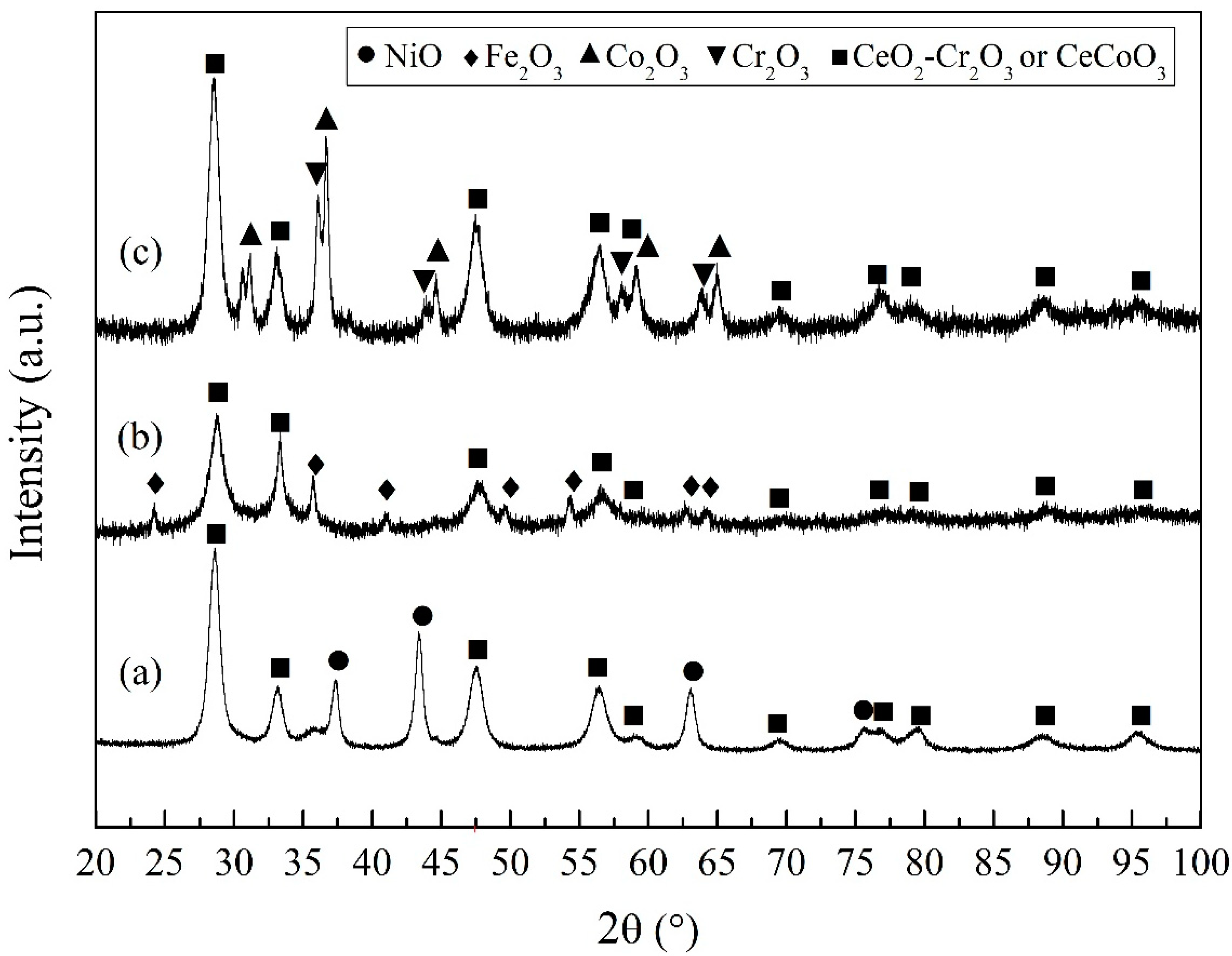
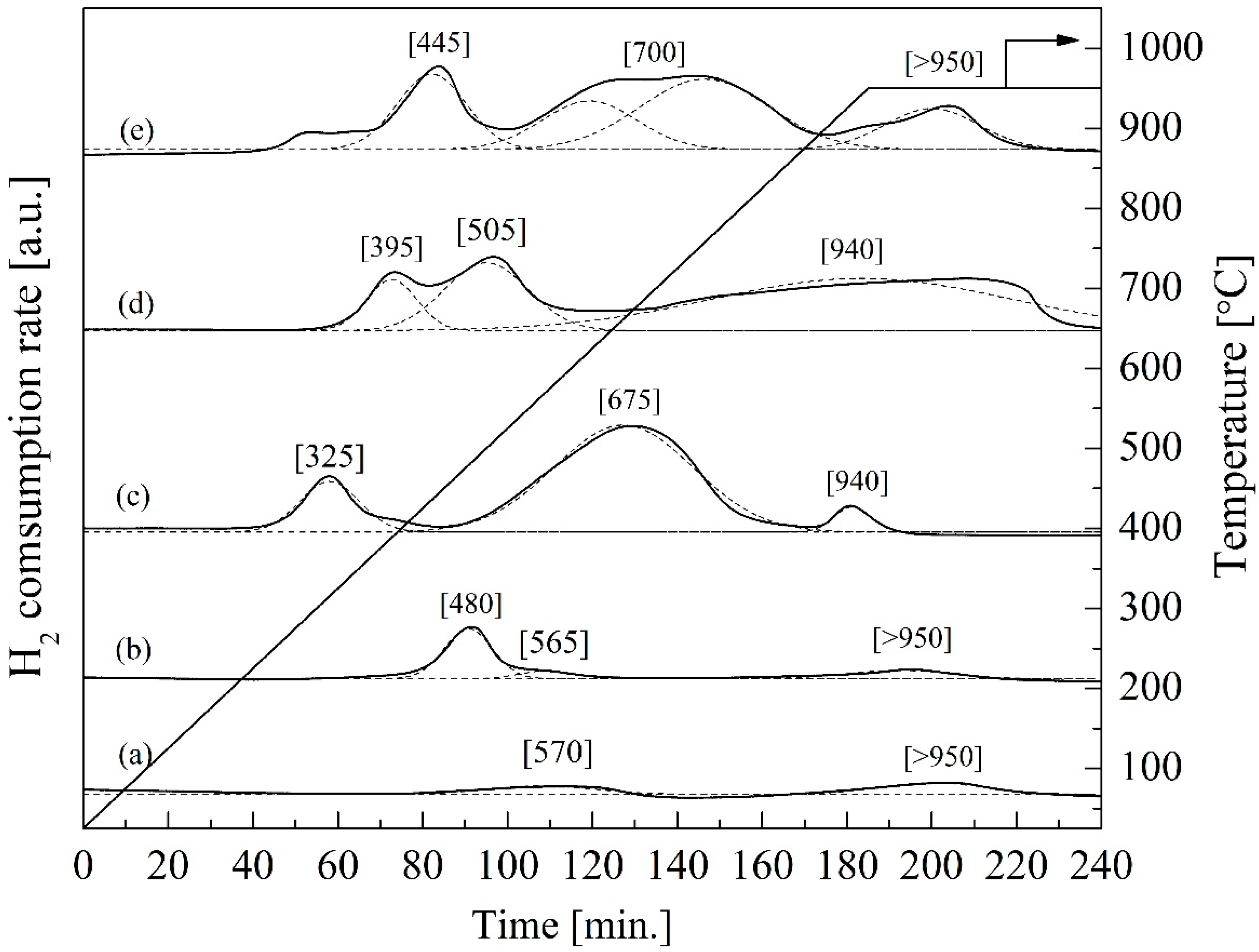
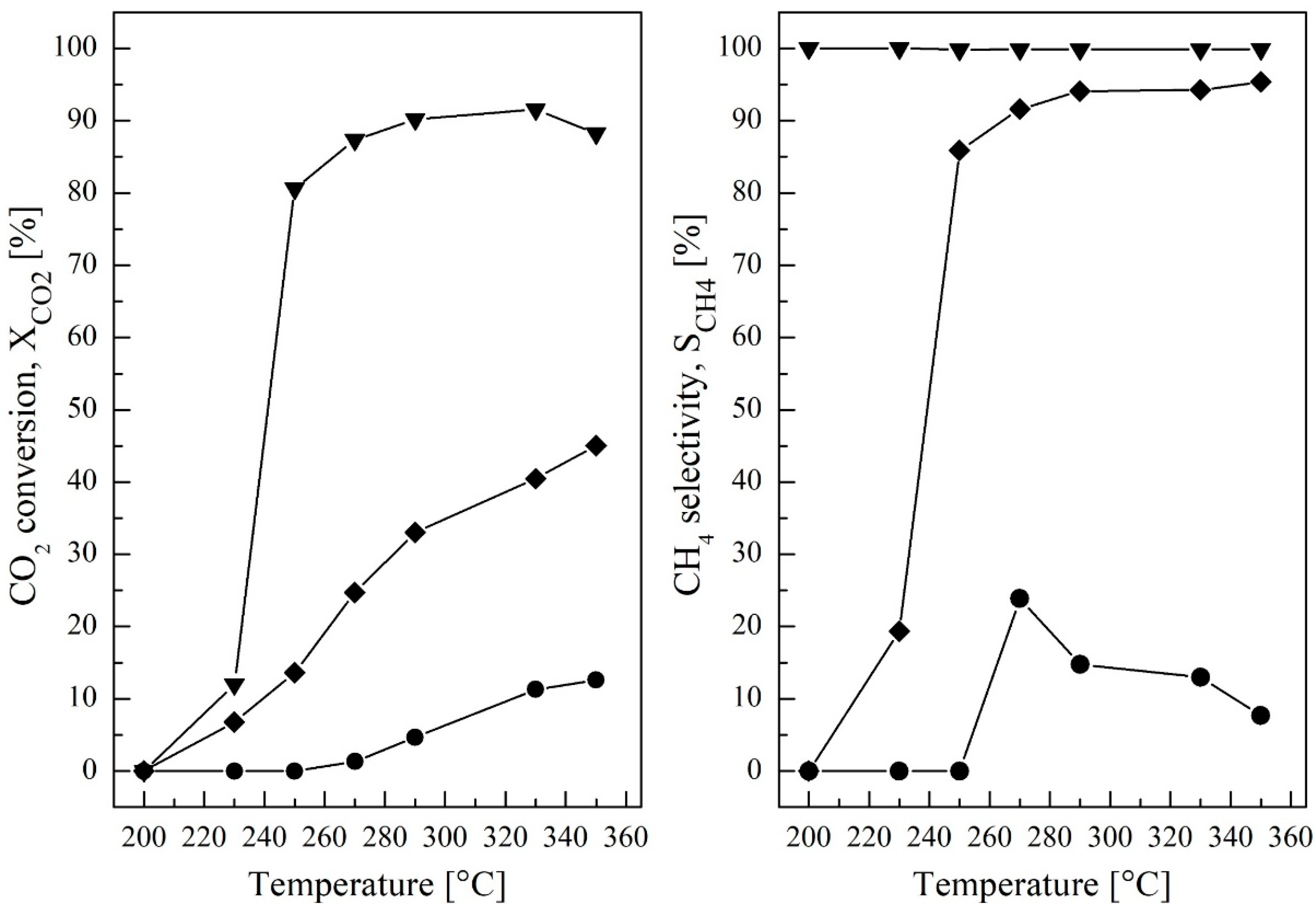
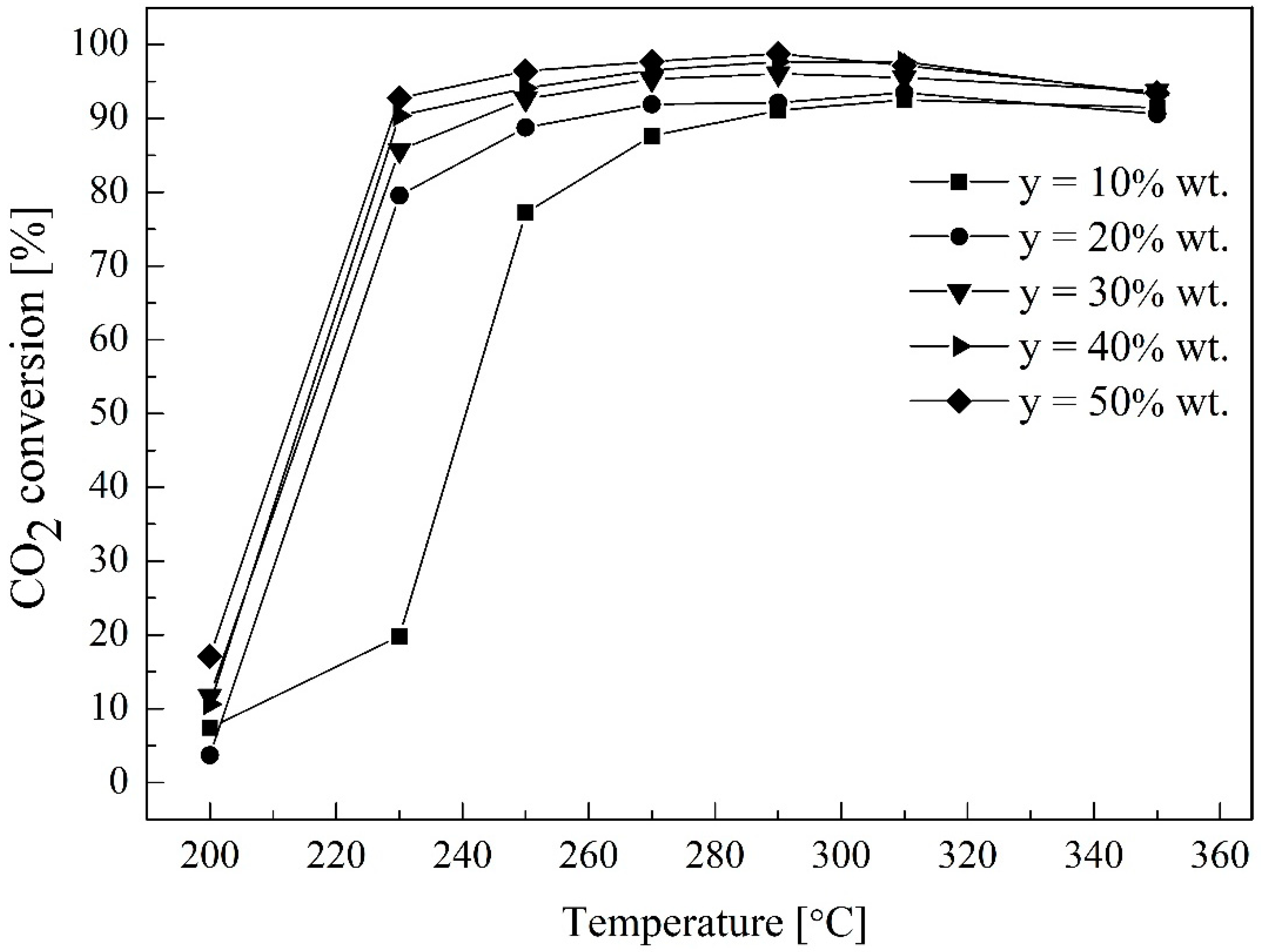
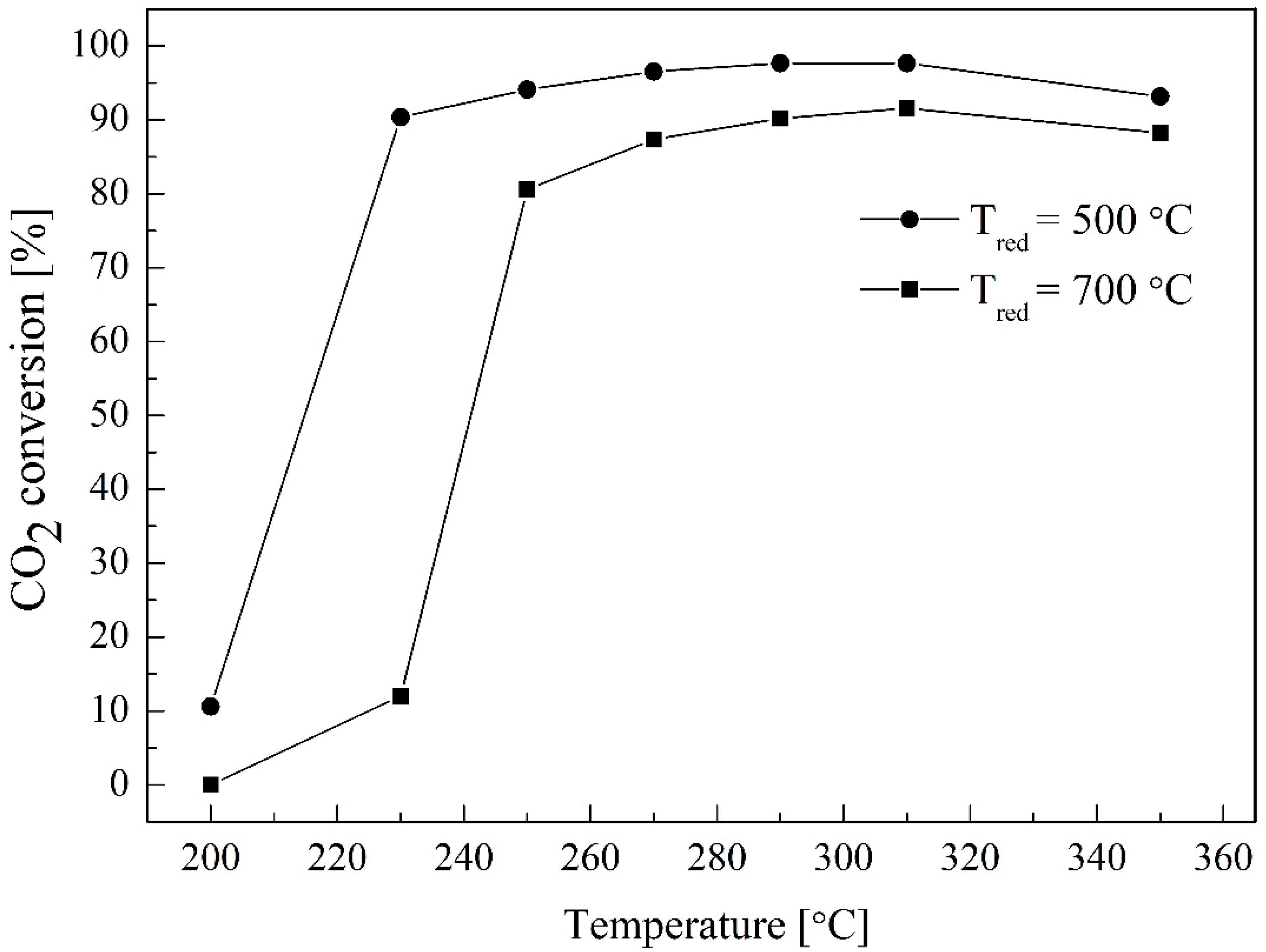
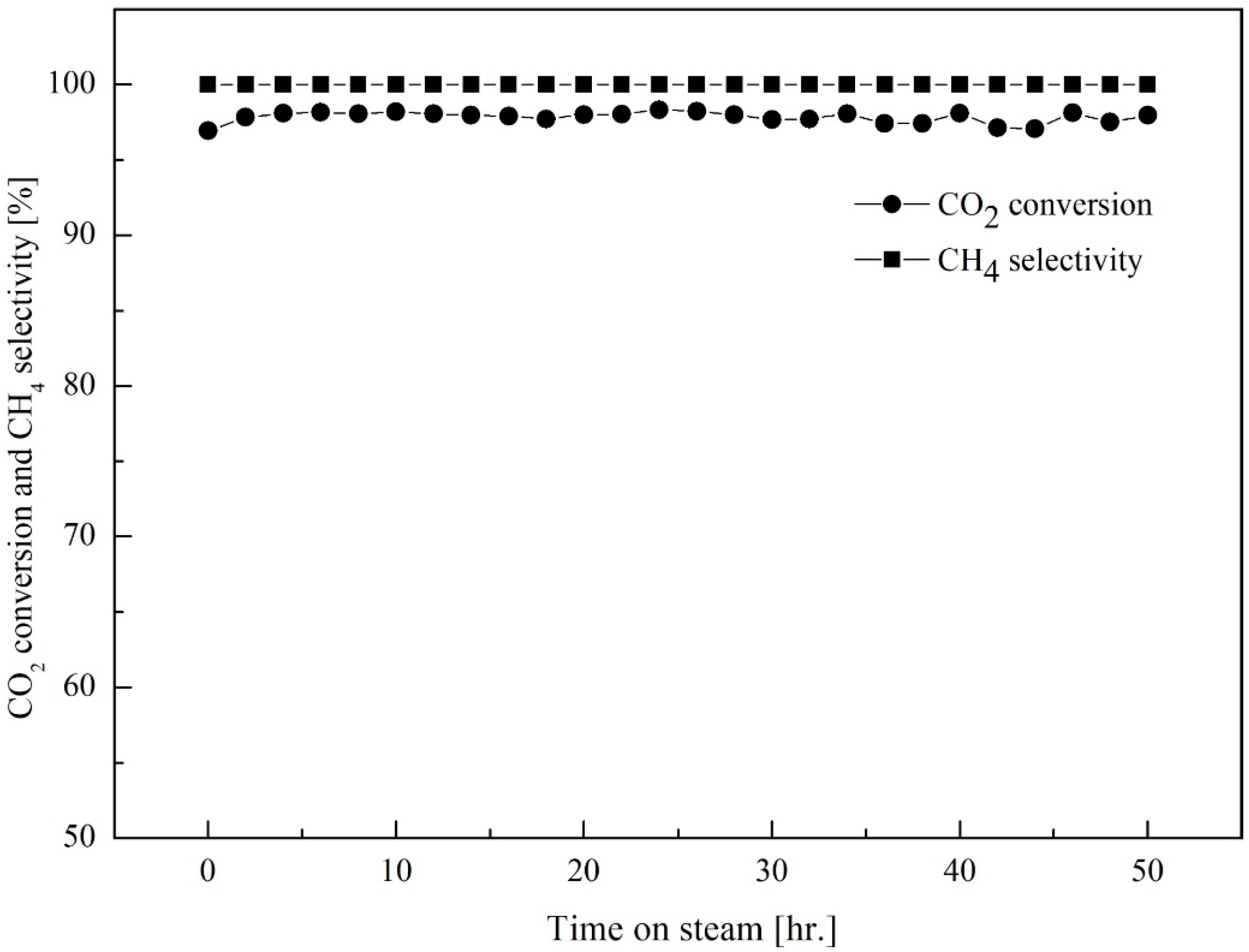
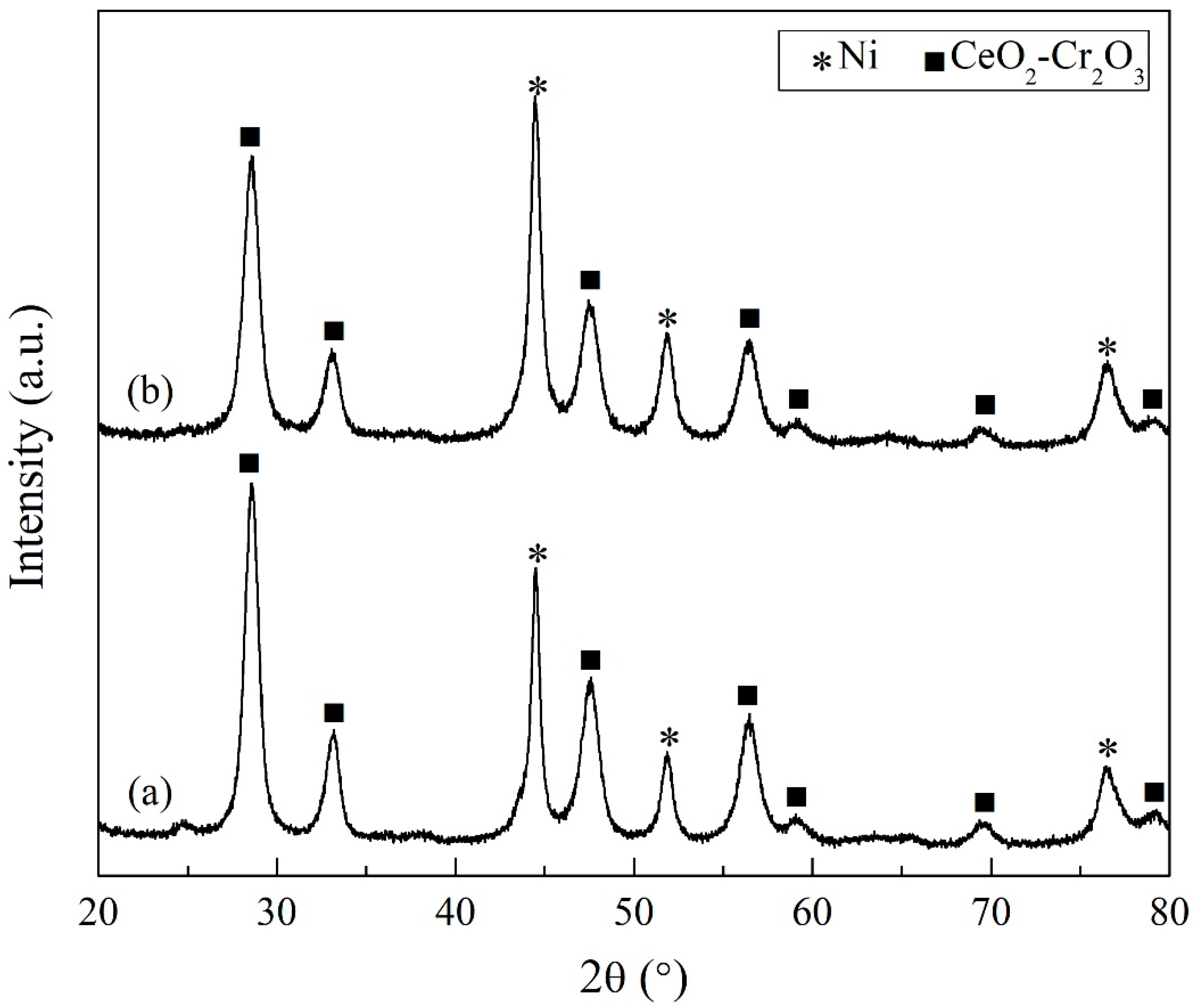
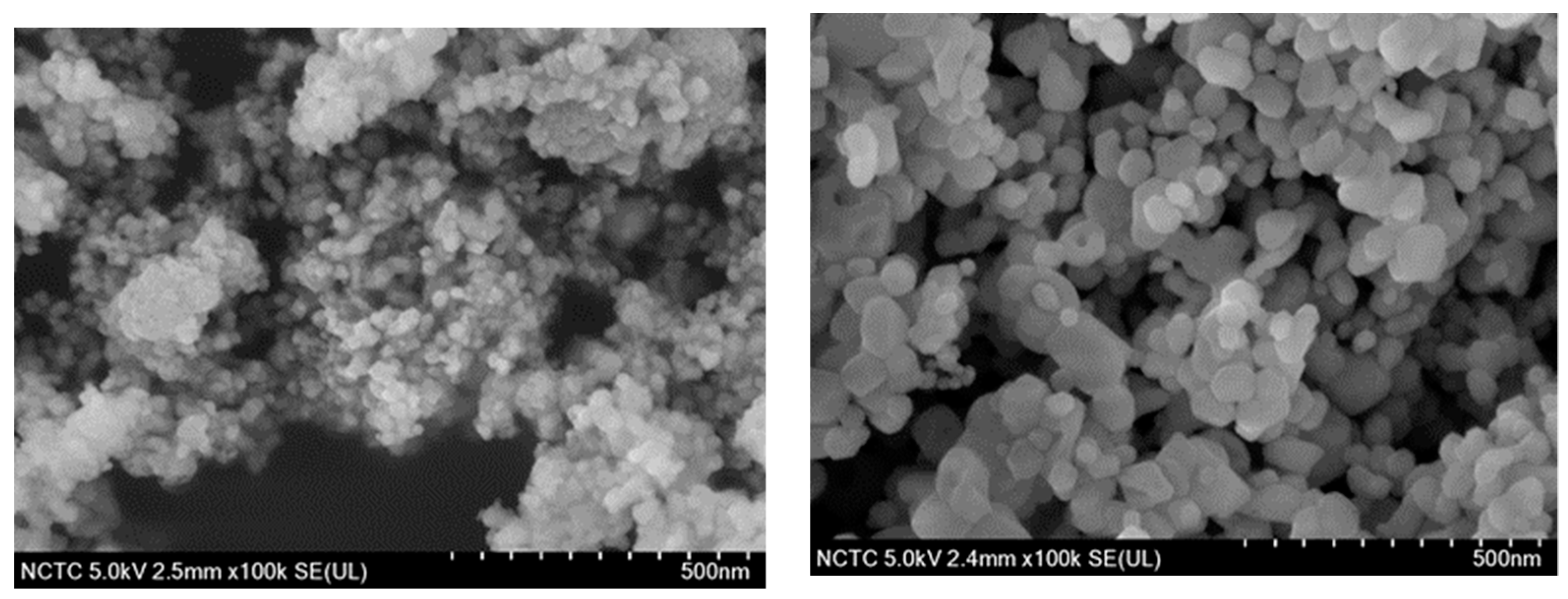
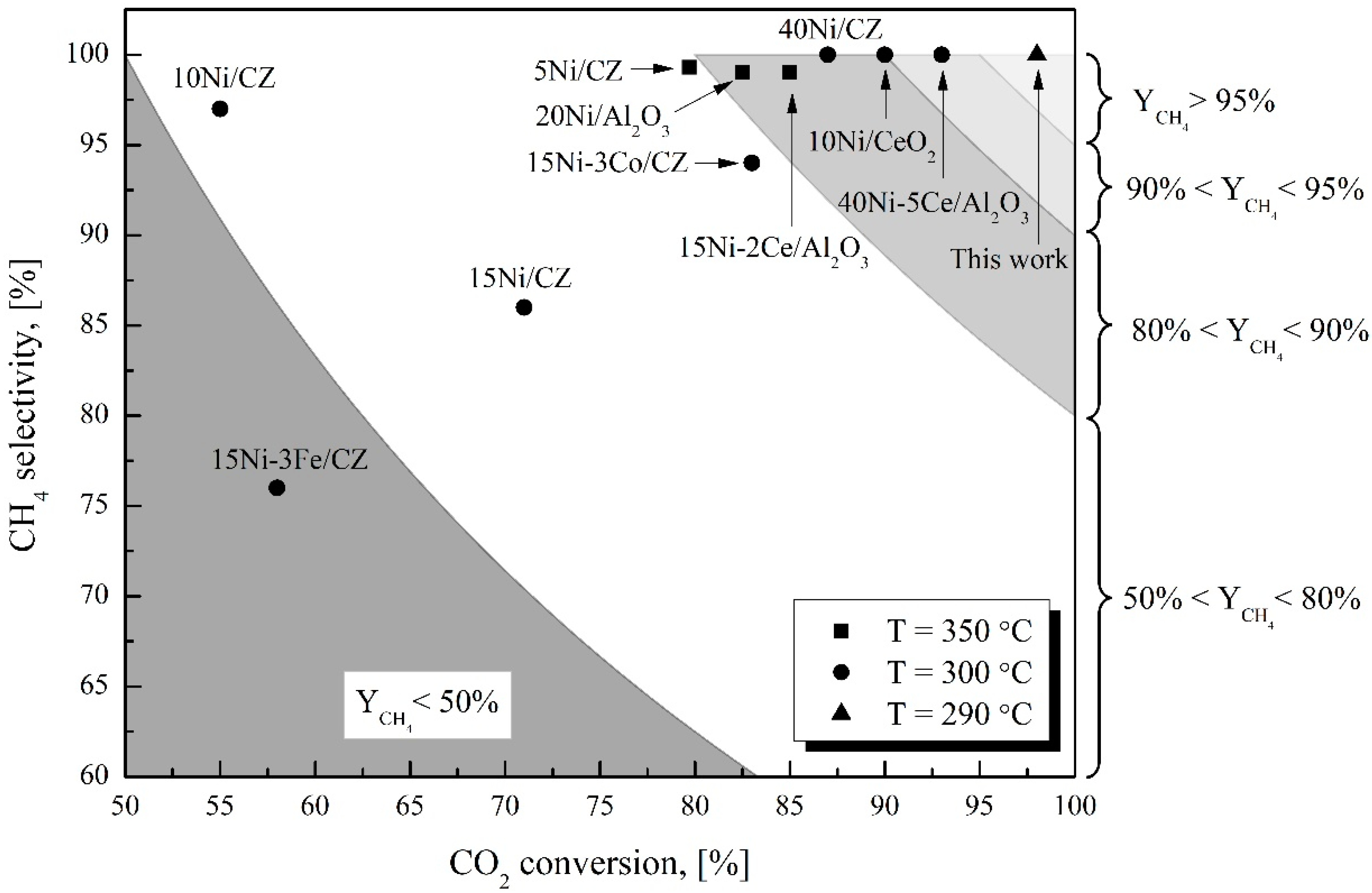
Publisher’s Note: MDPI stays neutral with regard to jurisdictional claims in published maps and institutional affiliations. |
© 2021 by the authors. Licensee MDPI, Basel, Switzerland. This article is an open access article distributed under the terms and conditions of the Creative Commons Attribution (CC BY) license (https://creativecommons.org/licenses/by/4.0/).
Share and Cite
Khajonvittayakul, C.; Tongnan, V.; Amornraksa, S.; Laosiripojana, N.; Hartley, M.; Hartley, U.W. CO2 Hydrogenation to Synthetic Natural Gas over Ni, Fe and Co–Based CeO2–Cr2O3. Catalysts 2021, 11, 1159. https://doi.org/10.3390/catal11101159
Khajonvittayakul C, Tongnan V, Amornraksa S, Laosiripojana N, Hartley M, Hartley UW. CO2 Hydrogenation to Synthetic Natural Gas over Ni, Fe and Co–Based CeO2–Cr2O3. Catalysts. 2021; 11(10):1159. https://doi.org/10.3390/catal11101159
Chicago/Turabian StyleKhajonvittayakul, Chalempol, Vut Tongnan, Suksun Amornraksa, Navadol Laosiripojana, Matthew Hartley, and Unalome Wetwatana Hartley. 2021. "CO2 Hydrogenation to Synthetic Natural Gas over Ni, Fe and Co–Based CeO2–Cr2O3" Catalysts 11, no. 10: 1159. https://doi.org/10.3390/catal11101159
APA StyleKhajonvittayakul, C., Tongnan, V., Amornraksa, S., Laosiripojana, N., Hartley, M., & Hartley, U. W. (2021). CO2 Hydrogenation to Synthetic Natural Gas over Ni, Fe and Co–Based CeO2–Cr2O3. Catalysts, 11(10), 1159. https://doi.org/10.3390/catal11101159





